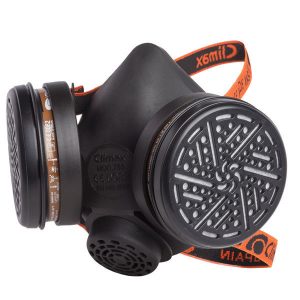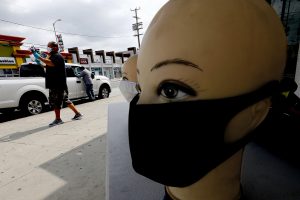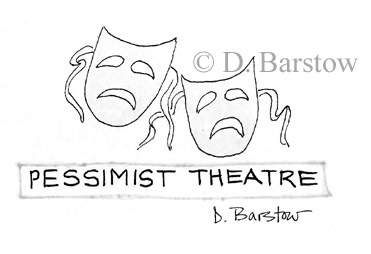Last updated on January 3, 2023

I tested these masks myself before COVID-19!
As I mentioned previously, I have a lot of personal experience using masks. I know what masks feel like and what they can and can’t do. I wore both paper and rubber masks for years in the studios, as a set painter. And we were perfect guinea pigs, because when you go home after hours of sanding or painting, your face and nose (and even ears) are full of any crap the masks didn’t stop! That’s good evidence!
I was in Local 729, Motion Pictures Set and Sign Painters, IATSE. All work equipment in the US, including masks, has to be approved by OSHA for safety, and we had to follow the rules. The only respirators we were allowed to wear for spray painting (think any wet work, like organic spray from a human) are the big rubber respirators with filters. We had to have one in our toolbox at all times. As the bosses always told us: “If you don’t have the tools, don’t take the job!”
Best type respirator for spray paint, organics or viruses: rubber, filters
 I used these a lot. The big rubber masks we used look similar to this one, but the newer ones look more like insect faces. Besides the fact that they fit so tightly so they keep out spray, there’s the fact that you can’t smell anything – and acrylic paint stinks so much (which is why spray paint smells), that’s a relief. Not surprisingly, both acrylic paint (which we used for spray painting cars, etc) and that in spray cans is highly poisonous. (Here in California, you are limited in how many spray cans you can buy at a time. I am happy that illegals who ruin the city with graffiti are also hurting their own bodies.)
I used these a lot. The big rubber masks we used look similar to this one, but the newer ones look more like insect faces. Besides the fact that they fit so tightly so they keep out spray, there’s the fact that you can’t smell anything – and acrylic paint stinks so much (which is why spray paint smells), that’s a relief. Not surprisingly, both acrylic paint (which we used for spray painting cars, etc) and that in spray cans is highly poisonous. (Here in California, you are limited in how many spray cans you can buy at a time. I am happy that illegals who ruin the city with graffiti are also hurting their own bodies.)
Cons: they are very heavy, in my opinion, and leave red rings around your face for a while afterwards. (Not good for preventing wrinkles!) You also have to keep changing the filters regularly. They also block your vision a little if you have a smaller face.
They’re expensive – the one I’m linking to here is only for hospital people now, but I think they’re about $50. We only got one every few months, and just changed the filters. Ugh, everyone hated them, but you have to wear them around toxic chemicals!
Dust masks and cloth masks for preventing infection from coronavirus
I tested a lot of these, too! Set painters and plasterers in the studio wear paper masks for dust and for sanding the plaster to make it smooth enough to paint over. These masks are for larger dry particles only. And they only work somewhat, as the sand or dust always gets through a little. Proof? Your nose knows! It is full of very dry cakey particles at the end of the day.
In my opinion, the first half hour with any cotton mask is great: you can still breathe pretty well, it’s dry, not moist yet from your own breath, and you can’t even smell the plaster yet. Two hours in and it’s useless. By the end of your shift, the dust has gotten inside on your face and your nose is full.

Of course you wear a new paper mask each day! Sometimes we changed them every couple of hours. Be sure to buy a box!
Cons: Every time you take them on or off they get weaker and have little cracks. And they get contaminated every time you touch them. Which you do all day long, because they are so itchy and the frame around it hurts your face, so you constantly are adjusting. They fog up your glasses or plastic eye masks. For a smaller face like mine, they also partly obstruct your vision. (Or maybe it’s my deepset eyes?!)
And hot? Hoo, boy, sweat city! Plus, ladies, it leaves an indent and splotches on your face. Wearing them frequently = wrinkles.
The cup type were more comfortable to wear (look similar to some surgical ones). Still, you always are touching your face bc they are so hard to adjust, hurt a little, you can’t see when they ride up, you can’t talk and they are freaking hot.
Short answer: All the others – and there were at least 3 types –always let in some dust. They won’t protect well against biological hazards like a virus, but if you are sick, or around sick people, they would be better than nothing.
What about cloth or DIY masks to protect against a virus?
Cloth doesn’t work. It’s very difficult to breathe through (notice how no one is wearing them!) and you inhale cloth fibers right into your lungs. They are fine for costumes or an emergency sandstorm.
Bonus: Eye goggles for more protection!
These are nice to wear if there are electric saws or spray paint flying around, or even if it’s just a windy day. They protect your glasses, too. I recommend the ones with small holes on the sides so they won’t fog up too much. I always kept a pair in my toolbox, as they aren’t too heavy, and since they’re plastic, they’re easy to clean.
To browse or buy
Lots of shapes on Amazon.
This cup-shape mask is the best over the counter medical mask. They fit fairly tightly, and also have room to breathe and talk. They hold their shape for a few hours. It is out of stock at the moment but should come back in soon, as they are not OSHA approved. You should look for this shape other places!
The pleated ones with ear loops is a type we wore a lot. Here are some very basic, inexpensive paper masks with ear loops. They don’t last for long, and really should be replaced each time you use it. They are not as tight as the cup-shape.
There’s another type we wore, with a metal criss cross and a replaceable cotton filter that fit in it. I can’t recommend them anyway, since the cotton always got soggy from your own breathing, and twisted up in the frame!
Here are some cat masks. Fun, but too expensive.
High rated but for frontline only – not available now.
A bunch of black dust masks for the avant-garde. Check the ratings on all masks.
Safety goggles: These goggles are cheaper, but I like this protection shape better, and they look more comfortable., also with good ratings.
Next up: Why I won’t wear any masks!



[…] When I worked as a set painter in the studios, all the old-timers used to say, “If you don’t have the tools, don’t take the job.” Clever, eh? […]